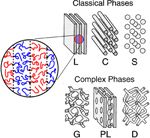EPJ E Highlight - Heterogeneous nanoblocks give polymers an edge
- Details
- Published on 30 July 2013

Study uncovers the effects of size variation in nanoscale blocks used in polymer mixes on their underlying architecture and inherent characteristics
Building structures by mixing lego bricks of two different sizes is child’s play. However, studying polymers endowed with an alternating nanostructure made of heterogeneous blocks is anything but straightforward. Theoretical physicist Mark Matsen, based at the University of Reading, UK, studies polymer mixes consisting of two-fold (AB) and three-fold (BAB) combinations of two types of nanoscale blocks. He has shown, in a study published in EPJ E, that the underlying heterogeneity of the blocks can cause polymers to switch to different nanoscale patterns and therefore display different properties. Numerous applications based on etching patterns on substrates, such as electronics, computer chips, and membranes endowed with a specific function, can benefit from such research.
The problem is that, for a long time, polymer experts thought that achieving such an ordered nanostructure required using nanoblocks of similar sizes. However, experimentalists have recently shown that is not necessarily the case. As it turns out, it is generally sufficient to synthesise block copolymers using less costly methods, which result in block components of heterogeneous sizes.
To understand the effect of heterogeneous blocks on such polymer melts, the author compares polymer architectures made of three blocks, namely BAB, and two blocks, namely AB. In this case, A blocks are of heterogeneous size and B blocks are of homogeneous size. He relies on a method called self-consistent field theory (SCFT), which involves approximating the effect of all the other polymers on any given polymer by an averaged effect.
Matsen found that the use of heterogeneous building blocks affects the morphological structure of polymers at the nanometric scale. He also realised that by using heterogeneous components, particularly with triblocks, it is possible to shift the width of sub-domains made of one type of polymer. This could, for example, help in improving the effectiveness of triblock-based refractive surfaces.
M. W. Matsen (2013), Comparison of A-block polydispersity effects on BAB triblock and AB diblock copolymer melts, European Physical Journal E, DOI 10.1140/epje/i2013-13044-9Comparison of A-block polydispersity effects on BAB triblock and AB diblock copolymer melts. M. W. Matsen (2013), European Physical Journal E, DOI 10.1140/epje/i2013-13044-9




